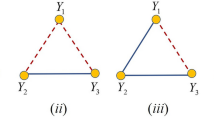Abstract
This paper presents a computational study of global characteristics of the US stock market using a network-based model referred to as the market graph. The market graph reflects similarity patterns between stock return fluctuations via linking pairs of stocks that exhibit “coordinated” behavior over a specified period of time. We utilized Spearman rank correlation as a measure of similarity between stocks and considered the evolution of the market graph over the recent decade between 2001–2011. The observed market graph characteristics reveal interesting trends in the stock market over time, as well as allow one to use this model to identify cohesive clusters of stocks in the market.



Similar content being viewed by others
References
Aiello W, Chung F, Lu L (2001) Random evolution in massive graphs. Annu Symp Found Comput Sci 42:510–521
Barabasi A, Albert R (1999) Emergence of scaling in random networks. Science 286:509–512
Barabasi A, Albert R, Jeong H (1999) Scale-free characteristics of random networks: the topology of the world wide web. Physica A272:173–187
Batagelj V, Zaversnik M (2002) Generalized cores.
Batagelj V, Zaversnik M (2003) An \(O(m)\) algorithm for cores decomposition of networks.
Boginski V, Butenko S, Pardalos PM (2003) On structural properties of the market graph. In: Nagurney A (ed) Innovation in financial and economic networks. Edward Elgar Publishers, London, pp 29–45
Boginski V, Butenko S, Pardalos PM (2005) Statistical analysis of financial networks. Comput Stat Data Anal 48:431–443
Boginski V, Butenko S, Pardalos PM (2006) Mining market data: a network approach. Comput Oper Res 33:3171–3184
Bollerslev T (1986) Generalized autoregresssive conditional heteroskedasticity. J Econ 31:307–327
Bollobás B, Thomason A (1985) Random graphs of small order. In: Karonski M, Rucinski A (eds) Random graphs. volume 118 of North-Holland Mathematics Studies, North-Holland, pp 47–97.
Bomze IM, Budinich M, Pardalos PM, Pelillo M (1999) The maximum clique problem. In: Du DZ, Pardalos PM (eds) Handbook of combinatorial optimization. Kluwer Academic Publishers, Dordrecht, pp 1–74
Broder A, Kumar R, Maghoul F, Raghavan P, Rajagopalan S, Stata R, Tompkins A, Wiener J (2000) Graph structure in the web. Comput Netw 33:309–321
Campbell J, Lo A, MacKinlay C (1997) The econometrics of financial markets. Princeton University Press, Princeton
Grane A, Veiga H (2010) Wavelet-based detection of outliers in financial time series. Comput Stat Data Anal 54:2580–2593
Huang WQ, Zhuang XT, Yao S (2009) A network analysis of the chinese stock market. Phys A Stat Mech Appl 388:2956–2964
Kim T, White H (2004) On more robust estimation of skewness and kurtosis. Financ Res Lett 1:56–73
Nagurney A (ed) (2003) Innovations in financial and economic networks. Edward Elgar Publishers, London
Nagurney A, Siokos S (1997) Financial networks: statics and dynamics. Springer, Berlin
Newman MEJ (2003) The structure and function of complex networks. SIAM Rev 45:167–256
Pattillo J, Veremyev A, Butenko S, Boginski V (2013) On the maximum quasi-clique problem. Discret Appl Math 161:244–257
Pena D (2001) Outliers, influential observations and missing data. In: Pena D, Tiao G, Tsay R (eds) A course in time series. Wiley, New York, pp 136–170
Rodgers JL, Nicewander WA (1988) Thirteen ways to look at the correlation coefficient. Am Stat 42:59–66
Seidman SB (1983) Network structure and minimum degree. Soc Netw 5:269–287
Spearman C (1904) The proof and measurement of association between two things. Am J Psychol 15:72–101
Tarjan R (1972) Depth-first search and linear graph algorithms. SIAM J Comput 2:146–160
Author information
Authors and Affiliations
Corresponding author
Appendix: 25 highest degree stocks for each time period
The sector “Funds, Trusts and Tracking Stocks” is denoted by “FTTS”.
Appendix: 25 highest degree stocks for each time period
See Tables 4, 5, 6, 7, 8, 9, 10, 11, 12 and 13.
Rights and permissions
About this article
Cite this article
Shirokikh, O., Pastukhov, G., Boginski, V. et al. Computational study of the US stock market evolution: a rank correlation-based network model. Comput Manag Sci 10, 81–103 (2013). https://doi.org/10.1007/s10287-012-0160-4
Received:
Accepted:
Published:
Issue Date:
DOI: https://doi.org/10.1007/s10287-012-0160-4




